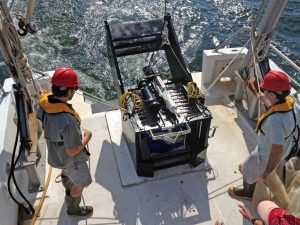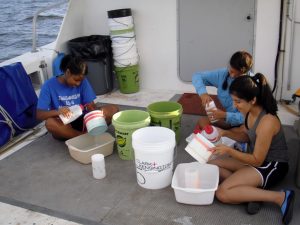Study Identifies Short-Term Changes in Plankton Communities after Oil Spill
– June 26, 2015
Scientists from the University of Southern Mississippi and Sultan Qaboos University assessed community responses to the Deepwater Horizon oil spill using data from a long-term plankton survey off the Alabama coast.
They observed significant variations in zooplankton community structure in May and June 2010 when compared to the same months between 2005 and 2009. By July 2010, these plankton communities returned to historic patterns. Contrary to expectations, many zooplankton taxa exhibited higher densities during 2010 relative to historic trends. Similar climate and environmental conditions observed across these years at their study sites suggest that the oil spill influenced these short-term variations in community structure. The scientists published their findings in the December 2014 issue of Environmental Research Letters: Change and recovery of coastal mesozooplankton community structure during the Deepwater Horizon oil spill.
Mesozooplankton are a crucial component of the marine food web and understanding their response to oiling is important to understand and predict ecosystem resiliency. Earlier research documented that zooplankton bio-accumulate oil and dispersant compounds and that carbon released as methane entered the planktonic food web (Graham, et al., 2010; Chanton, et.al., 2012; Almeda, et.al., 2013). Scientists in this study quantitatively analyzed plankton samples collected during May-August 2005 to 2010 from two sites located 20 and 30 kilometers south of Dauphin Island.
The density of many zooplankton taxa rose above historical trends during the period when the most oiling was observed on the Alabama shelf. For example, scientists observed significant density increases at the offshore site in June 2010 for ostracods (seed shrimp), cladocera (small crustaceans), bivalve larvae, and cyclopoid copepods. Wind conditions, atmospheric pressure, river discharge, water temperature, and salinity concentrations at these sites during the oil spill year generally resembled those of previous years.
The team offered possible explanations for the shift in plankton assemblage structure and density observed at their study sites, which were areas affected by Deepwater Horizon oil. Zooplankton may have migrated vertically to avoid surface waters with high hydrocarbon concentrations and bottom waters with low oxygen. Restricted fishing activity may have affected top-down control processes within the food web with larger predators feeding more heavily on smaller, zooplanktivorous fishes. Increased oil-degrading microbial populations following the oil spill may have enhanced microbial-zooplankton trophic linkages, stimulating secondary production.
The researchers noted that although the recovery in assemblage structure was relatively rapid, changes may have affected other components of shallow pelagic ecosystem such as taxon-specific feeding preferences of fish larvae. Improved knowledge about indirect effects of planktonic changes could contribute to better understanding of potential long-term spill impacts on fisheries and the Gulf ecosystem.
This study’s authors are Laure Carassou, Frank Hernandez, and William Graham.
************
This research was made possible in part by a grant from the Gulf of Mexico Research Initiative (GoMRI) to the Alabama Marine Environmental Science Consortium, the Northern Gulf Institute, and the project Resolving Deepwater Horizon Impacts on Highly Variable Ichthyoplankton and Zooplankton Dynamics in the Northern Gulf of Mexico. Other funders included the Alabama Department of Conservation and Natural Resources.
The Gulf of Mexico Research Initiative (GoMRI) is a 10-year independent research program established to study the effect, and the potential associated impact, of hydrocarbon releases on the environment and public health, as well as to develop improved spill mitigation, oil detection, characterization and remediation technologies. An independent and academic 20-member Research Board makes the funding and research direction decisions to ensure the intellectual quality, effectiveness and academic independence of the GoMRI research. All research data, findings and publications will be made publicly available. The program was established through a $500 million financial commitment from BP. For more information, visit https://gulfresearchinitiative.org/.
© Copyright 2010- 2017 Gulf of Mexico Research Initiative (GoMRI) – All Rights Reserved. Redistribution is encouraged with acknowledgement to the Gulf of Mexico Research Initiative (GoMRI). Please credit images and/or videos as done in each article. Questions? Contact web-content editor Nilde “Maggie” Dannreuther, Northern Gulf Institute, Mississippi State University (maggied@ngi.msstate.edu).







